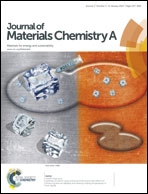Domain boundary structures in lanthanum lithium titanates†
Abstract
Perovskite-type lanthanum lithium titanate (LLTO) is attracting extensive interest because of its high intrinsic ionic conductivity. The material exhibits a complex microstructure with domains of various sizes and orientations that vary with the lithium content. Based on a systematic examination of both Li-poor and Li-rich LLTO compounds using state-of-the-art scanning transmission electron microscopy (STEM), we reveal the structures and composition of the domain boundaries (DBs) and consider their effect on Li-ion mobility and ionic conductivity, in the process positing the origin of the microstructural variations. DBs in this material are shown to consist essentially of two types: frequently occurring 90° rotation DBs and a much less common antiphase-type boundary. It is found that the 90° DBs are coherent interfaces consisting of interconnected steps that share La sites, with occupancies of La sites higher than in the domain interiors. The origin of microstructural variations in the two compounds is associated with different degrees of lattice mismatch strain at DBs in Li-poor and Li-rich materials. The lattice strain and associated O vacancies, as well as the high La occupancies, at DBs are expected to result in lower interdomain Li-ion mobility, which will have a deleterious effect on the overall ion conductivity.


 Please wait while we load your content...
Please wait while we load your content...